
Guests
- Carroll Bogertdeputy executive director for external relations of Human Rights Watch. Bogert worked closely with Tim Hetherington.
- Christina Larsonis a contributing editor to Foreign Policy magazine. She worked with photojournalist Chris Hondros.
- Mohamed Abdel Dayemcoordinator of the Middle East and North Africa Program at the Committee to Protect Journalists.
Award-winning photojournalists Chris Hondros and Tim Hetherington, director and producer of the documentary film Restrepo, were killed Wednesday when they came under fire in Libya. Hetherington and Hondros, who had covered conflict zones around the world, were part of a group of six photographers reporting on the Libyan conflict in a particularly dangerous part of the besieged city of Misurata. We speak with Carroll Bogert of Human Rights Watch, who worked closely with Hetherington commissioning and disseminating his photos from war-torn regions. Most recently Hetherington helped photograph secret police files documenting the brutality of the Gaddafi regime. To discuss the life and work of Hondros, we speak with Christina Larson, a contributing editor to Foreign Policy magazine. We are also joined by Mohamed Dayem of the Committee to Protect Journalists, about the increasing dangers faced by reporters covering conflicts in the region. [includes rush transcript]
Transcript
AMY GOODMAN: Award-winning photojournalists Tim Hetherington and Chris Hondros were killed when they came under fire yesterday in the western Libyan city of Misurata. Hetherington and Hondros, who had covered conflict zones around the world, were part of a group of six photographers in a particularly dangerous part of Misurata. The city has become a deadly battleground between rebels and forces loyal to Colonel Muammar Gaddafi. Hetherington was killed in the attack, and Hondras died later from his injuries.
Hetherington posted his last Twitter update the day before he was killed. He wrote, “In besieged Libyan city of Misrata. Indiscriminate shelling by Qaddafi forces. No sign of NATO.”
Two other photojournalists were injured in the blast: Michael Brown of the Corbis Agency and Guy Martin of Panos Pictures. Doctors at Misurata’s Hikma Hospital said seven rebel fighters and a Ukrainian doctor were also killed in the shellings. A hundred twenty people were wounded.
Hondros received war photography’s highest honor, the 2005 Robert Capa Gold Medal, for his work in Iraq. He was also a 2004 Pulitzer Prize finalist for his, quote, “powerful and courageous coverage” of unrest in [Liberia].
Hetherington co-directed the Academy Award-nominated documentary Restrepo. The documentary film, which he co-directed with author Sebastian Junger, focused on a platoon of U.S. soldiers serving in the remote and highly dangerous Korengal Valley of Afghanistan. The film won the Grand Jury Prize at the Sundance Film Festival last year. Democracy Now! covered Sundance last year. Hetherington thanked Sebastian Junger and dedicated the prize to the, quote, “Restrepo Generation.”
TIM HETHERINGTON: To work with Sebastian has been just the most incredible honor. You know, we just made a great team, and he’s been a rock for me emotionally, as well. I’d like to thank him. I’d like to thank my mom, as well, for putting up with what I do. And lastly, I’d like to dedicate the prize for the Restrepo Generation, to those hundreds of thousands of soldiers, men and women, that come back to this country and have become invisible. And this film is for them. Thank you very much.
AMY GOODMAN: That was Tim Hetherington at the 2010 Sundance Film Festival award ceremony. Sebastian Junger, his co-director, said yesterday, quote, “There is no way to express my devastation and sorrow at the death of my dear friend Tim Hetherington in Misrata, Libya. Tim was one of the most courageous and principled journalists I have ever known. The good that he accomplished — both with his camera, and simply as a concerned person in some of the most devastated countries in the world — cannot be measured. I can’t believe he is truly gone,” Junger wrote.
To talk more about Tim Hetherington and Chris Hondros, we’re joined by Carroll Bogert, deputy executive director for external relations of Human Rights Watch. Carroll worked closely with Tim, commissioning and disseminating his photos from war-torn regions. Christina Larson is with us from Washington, D.C. She’s contributing editor to Foreign Policy magazine. She has worked with Chris Hondros. And Mohamed Dayem is with us — he is the head of the Middle East and North Africa program at the Committee to Protect Journalists — to talk about the increasing dangers faced by reporters covering conflicts in the region.
Carroll, let’s begin with you. Tell us who Tim Hetherington was.
CARROLL BOGERT: Well, he was a remarkable friend, but he was also an incredibly committed journalist. There are different kinds of journalists in our world, and Tim is a kind of journalist who is impelled to tell the story. He’s not just doing a job. He’s not just going to work. He would find a way to tell those stories however he could. So, whether he was on assignment for Vanity Fair or for Human Rights Watch, the important thing for Tim was to tell the stories of the people whom he met in the field. He wasn’t just cruising from conflict to conflict. He wasn’t a kind of swaggering war photographer who was in it for the money or the glory. He was in it to expose stories that weren’t otherwise being exposed, because people wouldn’t go to the kinds of places that Tim Hetherington was willing to go to. He lived for eight years in Monrovia, the capital of Liberia, covering a civil war that nobody was paying attention to in the mainstream media. He was a very unusual person.
AMY GOODMAN: I wanted to turn to a clip of the film for which he was nominated for an Oscar, the film he did with Sebastian Junger. It’s called Restrepo.
TIM HETHERINGTON: I take you to places that you rarely get to see.
SEBASTIAN JUNGER: My job is to show the world as it is.
TIM HETHERINGTON: We wanted to create this kind of very visceral war film from a soldier’s perspective.
SEBASTIAN JUNGER: How men cope with combat psychologically and emotionally and how society deals with war morally is really, really important. I think what’s very, very simple about war is the emotional experience of it.
TIM HETHERINGTON: Take a young group of men, put them together, and this is how they are. And this is how wars have been prosecuted for millennia.
SEBASTIAN JUNGER: What I wanted to do was capture their experience.
TIM HETHERINGTON: What they go through needs to be seen and needs to be digested by the American public.
SEBASTIAN JUNGER: It’s helpful to have a very real and honest and accurate version of what happens in combat. I want people to walk out of the cinemas thinking, “My God, I didn’t know war was like that.”
AMY GOODMAN: That was Sebastian Junger and Tim Hetherington talking about their film Restrepo. Carroll, what did you do at Human Rights Watch with Tim in terms of getting out his photographs? And when did you last speak to him? What was he trying to accomplish in Libya?
CARROLL BOGERT: Well, we assigned him to cover stories for us. We sent him to Darfur, to Chad, to Sri Lanka, to Guinea. We worked with him in a number of conflict regions. We had his two films — his film about Liberia and his film about Afghanistan — in our film festival. We mounted exhibits of his photography. Tim and I lectured on photography and human rights in various countries around the world. He was a very close partner of ours. And the kinds of issues that Tim was interested in covering are precisely the kinds of issues that Human Rights Watch is interested in raising the profile of, so we had a natural and symbiotic and very close relationship.
AMY GOODMAN: Why did he choose to go to Libya?
CARROLL BOGERT: Well, Libya was certainly the story of the moment, and it’s a story where, as in Liberia, as in all the other conflicts that I just mentioned, civilians were really under attack. What we’re seeing in Misurata today is indiscriminate shelling of civilian populations. And I’m sure Tim would want us to remind the viewers that two photojournalists have died, but hundreds and hundreds of Libyans have died in Misurata, because Gaddafi’s forces are using cluster munitions, Grad rockets, which have no guidance system and, again, explode indiscriminately in civilian areas that are under attack. That’s the story in Libya that Tim wanted to cover.
AMY GOODMAN: Tim Hetherington died in Libya yesterday, as did Chris Hondros. And we’re also joined by Christina Larson with Foreign Policy magazine, who has worked with Chris. Christina, our condolences, as well. Can you talk about Chris, his history, what he was doing in Iraq to, most recently, in Libya? He died next to Tim Hetherington. Tim Hetherington, when he was brought to the hospital, was already dead, and Chris Hondros died in the hospital.
CHRISTINA LARSON: Right, that’s correct. Chris sustained a brain injury, and he went into a coma. And they tried to revive him, but he passed away a few hours after Tim did yesterday.
Chris grew up in the small town of Fayetteville, North Carolina. He worked for a paper in North Carolina. And then, in the late '90s, he began freelancing in Kosovo and really cut his teeth as sort of — in an act of both bravery, personal bravery, and feeling like he needed to tell the story, somewhat similar to what we've heard about Tim. He was compelled to bring these images and these ideas to people who otherwise wouldn’t see them, to whom war would seem like an abstraction. For the past decade or so, he’s been a staff photographer for Getty Images. He has traveled more than a dozen times to Iraq. He’s also traveled to Afghanistan. He worked side by side with Tim at some points in Liberia, Pakistan, many other places, Haiti recently. Chris also did some work outside of Getty, including a photo essay about Haiti earlier last year for Foreign Policy, and I worked with him on that. And I should say, we’ve been friends for several years, because we were both alumni of the International Reporting Project, which is a journalism fellowship based in Washington.
He — you know, just to talk a little bit about Chris and his work and the person behind his work, I think his awards, being nominated for a Pulitzer, winning, as you mentioned, the Robert Capa Award, speak for themselves about the quality of his work. As an individual, he was compelled to get close to the action. Some photographers, you find ways to use long lenses to take pictures from a distance. But Chris always felt that he understood something different, and the pictures he showed express something different, the closer he was to what was going on. So, you know, he was — right before he fell in the mortar attack yesterday, he had sent back some really close-up shots of the rebel fighting in Libya.
Chris also was someone who had — he was dedicated to telling stories over the long term. And that’s why he kept going back to Iraq. I know that he — you know, when Iraq seemed to be on the back burner of the American conscience, it was something that he kept pushing his editors at Getty to let him do, because he felt that it was really important that we see not just how something begins, but how it plays out.
Another insight of Chris into his work was that he wanted to show not just the guns and mortar side of war, but how it affected the other people in war-torn places. So he did, for example, a really gorgeous photo essay for the Virginia Quarterly Review that was shots from a Humvee in Iraq of just street scenes in Baghdad. And this was at a time — I think these photos were taken around 2006, 2007 — when foreign journalists had very limited access in Baghdad. And so, the series of images was both a comment on what street life was like, but also, in that case, the sort of limited access that he had, sort of seeing things through the window of this armored vehicle. There was a real intellect and a passion behind Chris’s work that I think — that, combined with his courage and his technical skills, really allowed him to do fabulous things.
AMY GOODMAN: And people can go to our website and see his photographs at democracynow.org. We did get a chance to interview Chris Hondros on April 5th, 2007, about the award-winning photographs he took in the northwestern Iraqi city of Tal Afar in 2005. Chris was embedded with U.S. troops when they opened fire on a family of eight approaching a checkpoint in a car. Both parents were killed while the six children in the backseat looked on.
CHRIS HONDROS: It was in January 2005, and I was embedded with U.S. Army troops in Tal Afar in northern Iraq. I’d been sent there by the Army. I had wanted to go to Mosul, where there were some battles going on at the time, but I’d been sort of waylaid to go to Tal Afar, because you don’t always get the embeds that you want in Iraq. And I was with a group of soldiers on a routine evening patrol around dusk, about 6:00 or so, after the — right around the time where the curfew was held in Tal Afar, and a car on the darkened streets sort of appeared in the distance and started coming down the boulevard toward the soldiers. As is well known, you know, the soldiers don’t like cars coming towards them. They fear suicide bombers and things. They weren’t sure what to do. They fired a few shots. The car kept coming, and so they shot up the car. And tragically, an Iraqi family was in the car, parents and six children, and the parents were killed instantly. And I documented that event.
AMY GOODMAN: And then the children that came out of this car.
CHRIS HONDROS: Well, you know, the children — one of the children — I mean, the children were, of course, terrified and covered in — the blood had splattered in the car, and they were covered in blood. The soldiers realized the mistake immediately and rushed up, took the children out. They weren’t sure who was injured, who was not, and they sort of evaluated the children on the sidewalk, in front there. I photographed all that. And one of the children, it turned out, had a gunshot wound, as well, and they were all transported to the local hospital and dropped off there.
JUAN GONZALEZ: A really powerful image it is, especially of one little girl with blood spattered all over her. Did the soldiers at all try to prevent you from taking any of those photos?
CHRIS HONDROS: No, they didn’t, really. I mean, they were sort of in the moment, as so often happens in these situations, you know. Everybody was in the moment and doing their things, and I was photographing just sort of discreetly there just what was going on. And they never tried to stop me in any way at the time.
AMY GOODMAN: Describe the little girl, this most famous image of the little girl next to a soldier’s boots and weapon.
CHRIS HONDROS: Yeah. Her name, as it turns out, is Samar, Samar Hassan, and she was five years old at the time of the picture. And, you know, the soldiers — there weren’t that many soldiers. It was just part of a platoon, maybe five or six, one medic for the whole thing. So the medic was one by one trying to evaluate the children to see what sort of injuries they might have had, and Samar was there just crying, you know, while one of the other children was being attended to. And she’s standing next to the soldier. I think one of the reasons the photo had this sort of resonance that it does is because it has a sort of empty feeling: you know, the poor girl, all alone in the world now, just standing there in the dark, you know.
AMY GOODMAN: That was Chris Hondros on Democracy Now!, April 5th, 2007. To see the whole interview, you can go to witnessesu”>democracynow.org, as we talk to Chris and Tim’s friends. Chris actually was going to be married on April 6, 2011 — rather, on August 6, 2011. We’re also joined by Mohamed Dayem. He is with the Committee to Protect Journalists. Put these two deaths in the bigger picture of what’s happening now in Libya.
MOHAMED ABDEL DAYEM: The big picture in Libya is grim. The Committee to Protect Journalists, since the beginning of the uprising, which has slowly turned into a civil war, has documented well over 80 violations of press freedom: obviously, these two fatalities, along with two previous ones, for a total of four fatalities in Libya so far, as well as 49 detentions, about a dozen physical assaults, and confiscation of equipment and jamming of broadcast signals. And it really spans the gamut, the types of violations that have taken place against journalists in Libya.
AMY GOODMAN: Can you talk about what Gaddafi is trying to accomplish? And do you think that the arrests and the killings of the journalists are deliberately going after journalists or part of the overall attacks? So many — we don’t know how many hundreds, if not thousands, of Libyans have died.
MOHAMED ABDEL DAYEM: Well, when we look at the number of detentions, for example, we see a very clear pattern, where journalists are detained at the front lines by militiamen. They’re abused by those militiamen for a number of days, a short number of days, and then handed off to the political leadership in Tripoli, who then treat them with a modicum of respect and then use them as bargaining chips with the international community. And that’s largely the result of the fact that the Gaddafi regime has very few other bargaining chips, and so they’ve decided, at some point along the line, that they’re going to — they’re going to detain journalists and use them to extract political concessions from the international community. And that is simply unacceptable.
AMY GOODMAN: And how does this compare to the rest of the region, Mohamed?
MOHAMED ABDEL DAYEM: Well, the Middle East and North Africa has been a terrible place for journalists to work, a very dangerous place for journalists to work. Of the 14 media fatalities documented by the Committee to Protect Journalists in 2011 so far — I’m sorry, of the 16, 12 have been in the Middle East and North Africa. So that really gives you a sense of how dangerous of a place this is relative to other parts of the world.
AMY GOODMAN: Can you talk about what journalists can do?
MOHAMED ABDEL DAYEM: Well, many of these — many of these journalists are veteran journalists. Tim and Chris both have worked in a couple of dozen war zones prior to this. So these are veteran journalists who know what they’re doing. And we always advocate that it’s really up to the journalists and their media organizations to assess the risk themselves and to determine how and where they can work and when the risk becomes too high and when they need to withdraw. We obviously always consult with those journalists and try to share our experiences with them and what we’re hearing from others working in that same situation or other similar situations. But ultimately, it’s really up to the individuals and the media organizations to make that call themselves.
AMY GOODMAN: Carroll Bogert, your final thoughts on your friend and colleague, Tim Hetherington?
CARROLL BOGERT: You know, one of the last projects that we worked on with Tim was in Libya. Our person in the east came into possession of a trove of secret police documents that really laid bare the repressive apparatus of the Gaddafi regime. We didn’t want to remove those documents from Libya, because they belong to the Libyan people, but Tim helped us to photograph hundreds and hundreds of pages of these documents. They may one day, Amy, serve as evidence at the International Criminal Court, because, as you know, the U.N. Security Council voted unanimously — even China and Russia voted — to refer the case of Gaddafi and his circle to the International Criminal Court. So, one of Tim’s last acts with us may be to help pursue and push forward a case for justice for Libya. And if and when that does happen, I think it will be part of the lasting legacy of Tim Hetherington.
AMY GOODMAN: And Christina, your final thoughts on your friend and colleague, Chris Hondros, who died soon after Tim yesterday in Misurata?
CHRISTINA LARSON: Right, well, I think Tim — I mean, I think Chris — Chris and Tim will both be missed, not only by the people who saw their images and were impacted them by from a distance, but from the many, many people, younger journalists, that Chris mentored and gave advice to. I mean, he was truly a pillar of a community that is always in need of support and encouragement, moral and practical. And, I mean, he was just the kindest person in allowing friends to use his satellite phone and giving a hand. I know that recently when he was in Egypt covering Tahrir Square, he stuck very closely by a fellow female photojournalist, because she was being manhandled in the crowd, and he made it a point not only to do his job, but to look out for the people he was traveling with. And I just think, you know, both his professional work and his personal qualities will be a lasting inspiration to people who try, like Tim and like Chris, to show Americans and others what war really is.
AMY GOODMAN: Well, I want to thank you all for being with us. As you’ve pointed out, for Chris Hondros and Tim Hetherington, the story wasn’t them; it was the people they covered. They showed that in all of their work. But yesterday, they were both killed doing their work. Tim Hetherington, the Oscar-nominated director of Restrepo and photographer in so many regions of the world, he lived in Liberia for eight years. And Chris Hondros, who is the Pulitzer-nominated photographer, worked in Iraq, died in Libya.
This is Democracy Now!, democracynow.org, The War and Peace Report. Back in a minute.
[break]
AMY GOODMAN: To see our interview with Chris Hondros, you can go to our website, as well as our interview with Anthony Shadid, one of four Times reporters, New York Times reporters in Libya, who were captured, brutalized, but were released. That’s at democracynow.org.

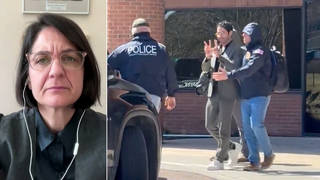

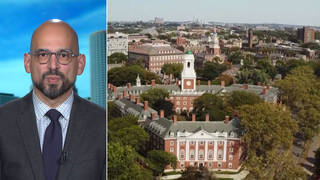
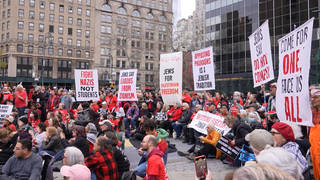

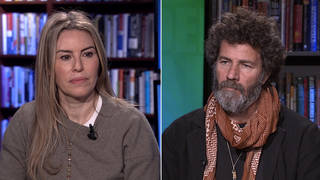

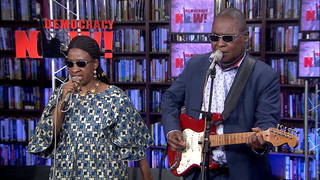

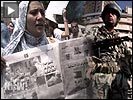

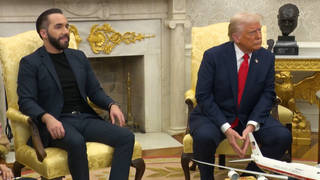
Media Options